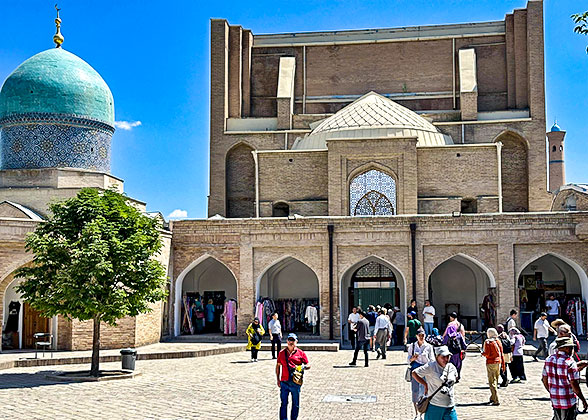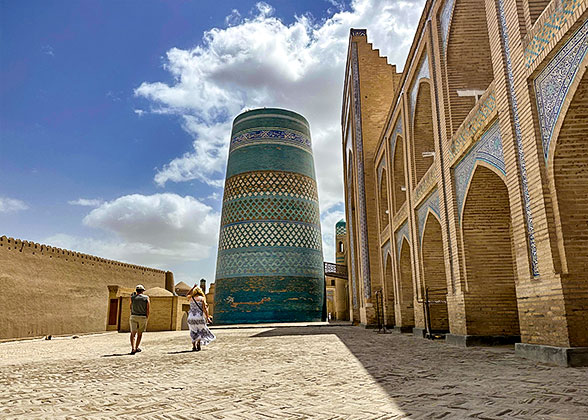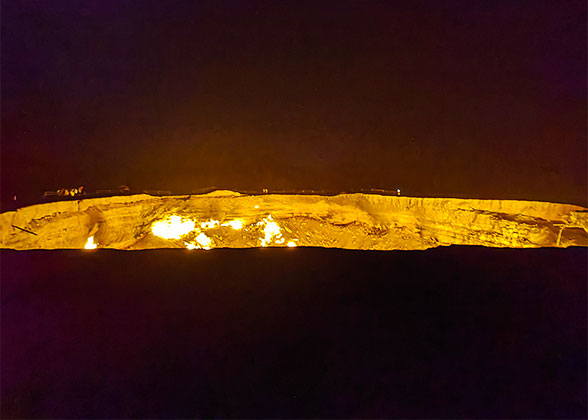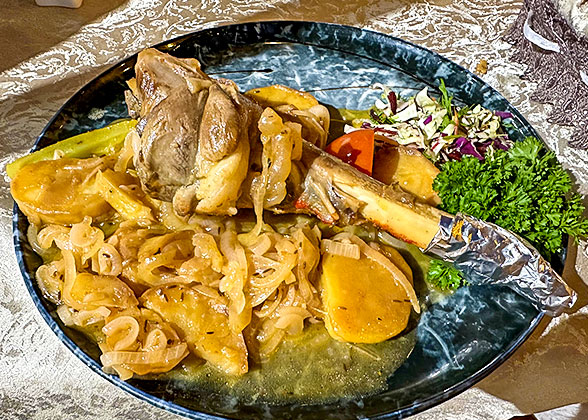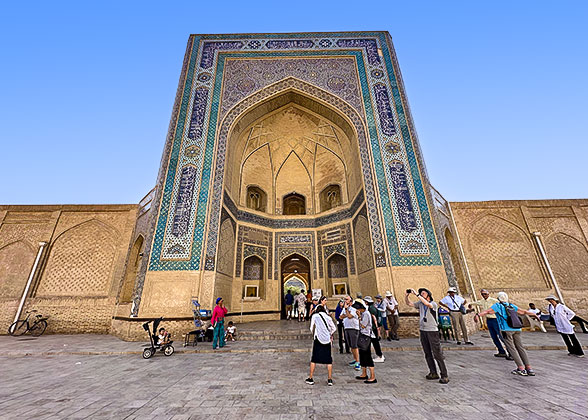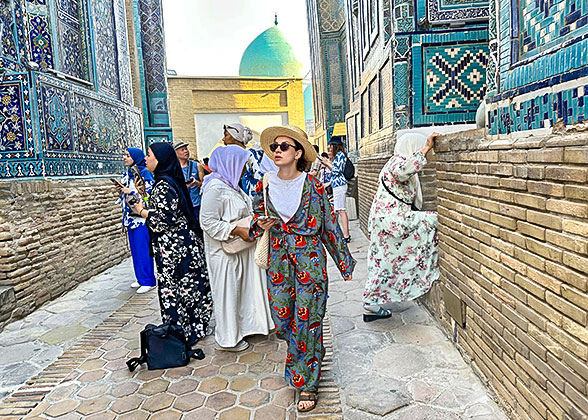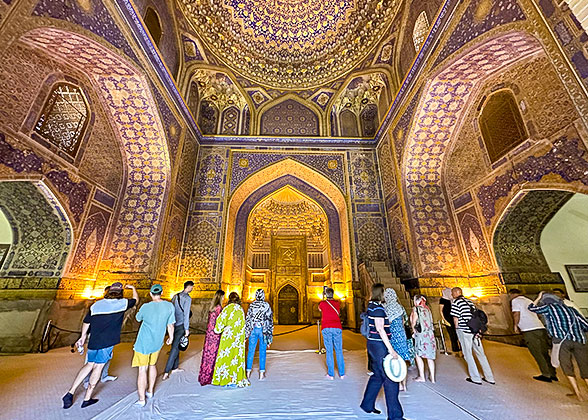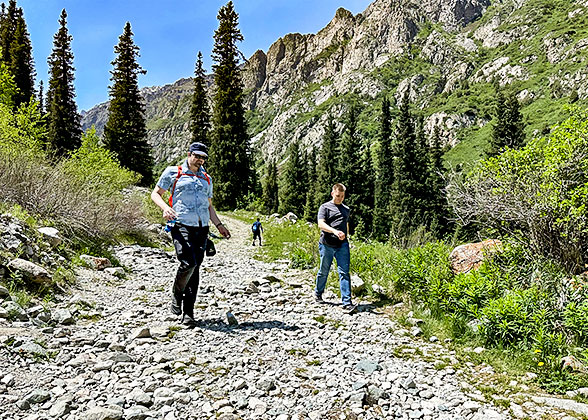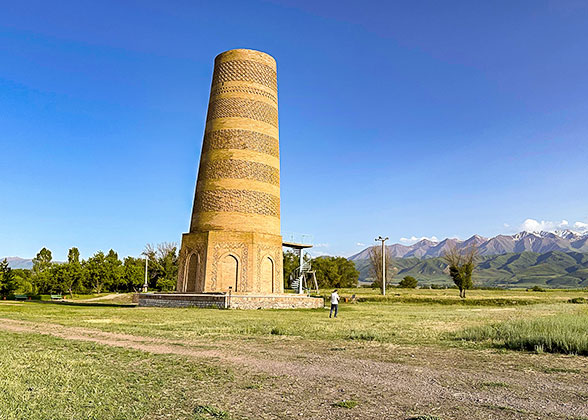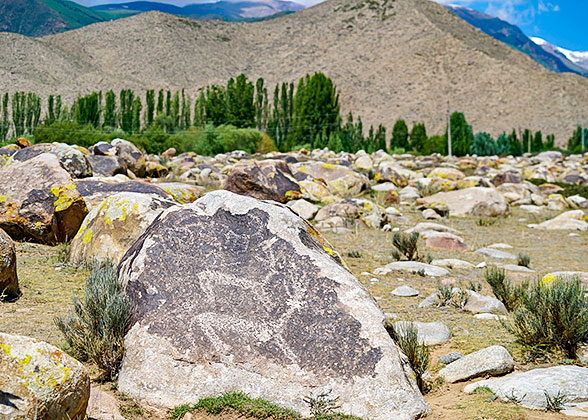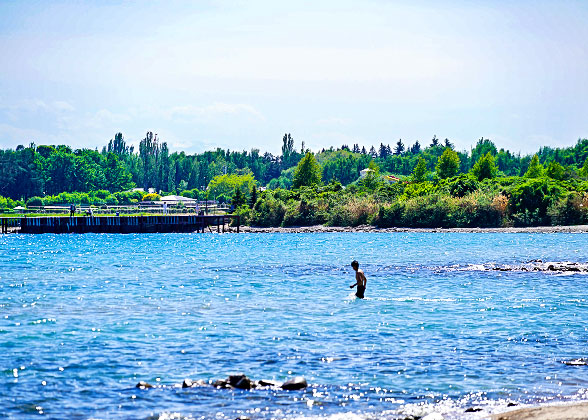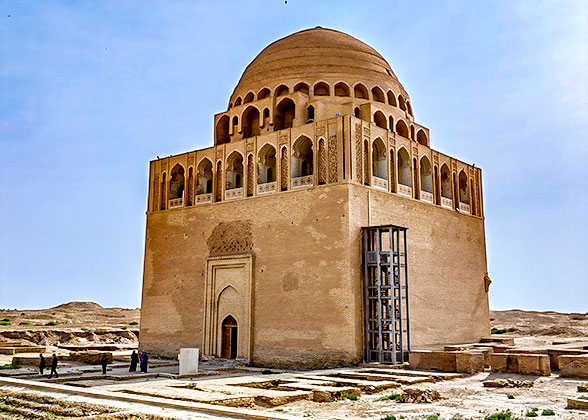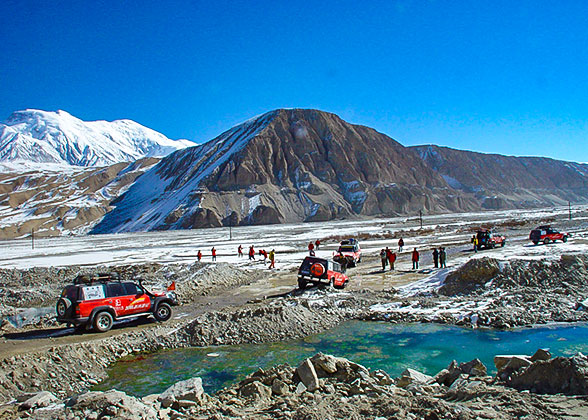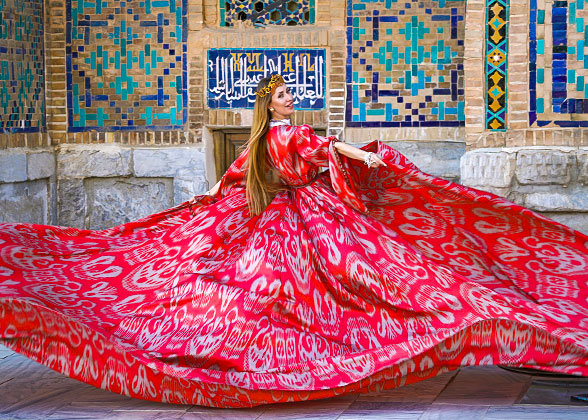Day 1: Arrive in Uzbekistan, Tashkent Airport Pick-up: Visit Khast-Imam Complex, Museum of Applied Art
A Journey to Khast-Imam Complex Your Uzbekistan Turkmenistan Kyrgyzstan tour package will start with a local driver's airport pickup in Tashkent. As Uzbekistan’s capital, this city boomed as a vital commercial hub on the Silk Road 2,000 years ago and became Central Asia’s largest and most populous city under the rule of the Soviet Union in the 19th century. After settling down at the hotel, our English-speaking guide and the driver will first escort you to the Khast-Imam Complex, Tashkent’s most celebrated square, whose traditional Islamic schools, mosque, and mausoleum introduce the most iconic Uzbek Islamic architecture. No matter the Barakh-khan Madrasah, Tilla Sheikh Mosque, or Abubakr Kaffal-Shashi Mausoleum, they will dazzle your eyes with intricate blue-tiled Islamic geometric patterns and calligraphy and azure domes shimmering under the sun. On the north corner of the square is the Islamic Institute of Imam al-Bukhari, one of Central Asia's most renowned centers of Islamic learning. Then, head southwestward to the Chorsu Bazaar. Beneath its huge green-and-blue dome, you can immerse yourself in the local life amidst the vibrant haggle of customers and the aroma of fruits and spices. Getting out of the teeming marketplace, proceed to the State Museum of Applied Art, which ranks among Uzbekistan’s richest repositories of traditional craftsmanship. Here, you can see various artistic treasures from all over the country, including intricate embroideries from Fergana, elaborate carpet weaving from Bukhara, and ceramics from Samarkand. Besides, it also holds artworks from China, India, and Japan. The museum building itself stands as a masterpiece of Oriental aesthetics, featuring an ornately patterned façade, delicately carved wooden columns, opulent ceilings, and meticulously crafted wall niches. Afterward, we’ll head to explore the remnant of the Soviet Union hidden underground, the Tashkent Subway. Constructed in 1977, the metro is a concentration of Soviet-style architecture. Each station possesses a unique character: some feature grand marble columns and glittering crystal chandeliers; others boast vaulted ceilings with honeycomb skylights. We will jump on the subway and head to Independence Square. A leisurely walk will lead you to go through Amir Timur Square, and today’s itinerary will conclude with the poignant Earthquake Memorial sculpture, which was built to commemorate victims of a fatal earthquake in 1966.  Uzbekistan Visa Requirements A visa-free policy is available to citizens of the EU and 66 other countries, including the UK, Canada, and New Zealand. While citizens of 50 countries, including the US, must obtain an e-visa. However, Americans under 16 and over 55 years old can enter Uzbekistan without a visa. As our itinerary involves entering Uzbekistan twice, make sure you apply for a double-entry visa, costing USD 35. Accommodation: Wyndham Tashkent (4 stars) or similar
|
Day 2: Fly to Urgench, Drive to Khiva: Kalta Minor Minaret, Juma Mosque, Tosh-Hovli Palace, Kunya-Ark
In the morning, the Tashkent driver will escort you to the airport for a flight to Urgench, where the local driver will pick you up and transfer you to the hotel in Khiva. As an oasis rising from the desert, Khiva is hailed as a “living museum” of Uzbekistan, preserving Islamic architecture from the 14th to the 19th centuries. After a short break, the local guide will accompany you to visit Ichan Kala, the inner city of Khiva, inscribed on the UNESCO World Heritage Site list. Enclosed by 10-meter-high (33-foot) walls, this old city contains nearly a hundred mosques and over sixty madrasahs. First, have a glimpse of two ancient Islamic schools, Muhammad Aminkhan Madrasah and Muhammad Rahim Khan Madrasah. Outside their huge portals, you’ll appreciate the striking, unfinished Kalta Minor Minaret. It is said that the ruler planned to build a 110-meter-high (360-foot) tower, on which one can see the skyline of Bukhara about 400 km (249 mi) southwest. However, its construction was halted in the 1850s after the Khan’s death, leaving this unfinished 29-meter-high (95-foot) glazed-tile marvel watching over his territory. Next, step through a wooden door into Juma Mosque, Khiva’s oldest mosque, built in the 10th century. Without a central dome, its prayer hall is supported by 218 dark-brown wooden pillars, on which you can still see the exquisite carved patterns. Then, journey northeast to the Tosh-Hovli Palace, a 19th-century complex symbolizing the grandeur of the Khanate of Khiva (1512-1920). Wander through its three courtyards and maze-like connecting corridors, and peer into the Khan’s chambers to see the original furnishings like beds, thrones, and copper vessels. If lucky, you may encounter Uzbek cultural performances in the palace. Afterward, we will pause at the striking turquoise dome of the Pakhlavan Makhmud Mausoleum before gazing up at the city’s tallest structure, the 56-meter-high (184-foot) Islam Khodja Minaret. If interested, you can climb up to the top to admire the panoramic view of the old city. Finally, we will probe into the Kunya-Ark, once the residence of rulers. Initially built in the 12th century and expanded in the 17th century, it is dubbed “a city within the city”. In the fortress, you can see the restored Summer Mosque, stable, jail, and harem. At dusk, ascend its meandering rampart to catch a view of the skyline tinged by a golden hue of the sunset.  Recommended Restaurant (at your own expense): Terrassa Cafe & Restaurant is quite popular among travelers and locals. Housed within a renovated Islamic school, it offers stunning sunset views, and if you dine here at night, you can see the illuminated Kunya-Ark and the Kalta Minor Minaret from its patio. Beyond breathtaking scenery, it offers Uzbek specialties, such as succulent kebabs and fragrant plov. Please keep in mind that a reservation is required if you want to dine on its terrace. Average Cost Per Person: UZS 160,000 (USD 20). Mastercard and Visa cards are acceptable. Address: Pakhlavan Makhmud 22, Khiva, Uzbekistan Meals: Breakfast Accommodation: Hotel Asia Khiva (3 stars) or similar
|
Day 3: Cross the Border to Turkmenistan; Visit Kunya-Urgench; Transfer to Darvaza
After breakfast, the driver will transfer you to the Uzbekistan-Turkmenistan border. After the customs formality, our Turkmen guide and the driver will transfer you to Kunya-Urgench, once the capital of the Khwarezm Empire in the 12th century. As one of the oldest cities in Central Asia, it served as a vital trading hub on the Silk Road. Kunya-Urgench exploration will begin at the local landmark, the Nedjmeddin Kubra Mausoleum, whose portal seems to be tilting; its blue tilework has faded away, but still appears to be outstanding with twin domes. After, visit the Turabek Khanum Mausoleum and the remnant of Mamun Minaret, which was built in 1011 and fell one century ago, leaving only its base. Look around, and the 62-meter-high (203-foot) Kutlug Timur Minaret will draw your attention. Standing at its foot and gazing upward, you’ll be staggered by Central Asia’s tallest tower, whose body was decorated with incised Islamic calligraphy. Finally, stop at the II Arslan Mausoleum and the Kyrkmolla Mausoleum. Continue driving southward, and we will dash into Darvaza Gas Crater, which has been burning for more than 50 years, created accidentally by Soviet geologists in 1971 after a failed drilling. En route, you may encounter some lakes and small exploration pits and spot wild camels. After about a 5-hour bumpy road car ride through the desert, we will arrive at the camp near the crater. Take a short break, and then head to the crater’s edge. The pit is 70 meters (230 feet) wide and 20 meters (66 feet) deep, in which its orange flames crack, making it seem to be the portal for Satan, hence dubbed "Door to Hell." At night, we will enjoy a barbecue dinner under the starry sky and take photos with the pit. ► Tip: Since it is quite jolting in the desert, you are advised to prepare a headrest and some motion sickness medicine. Dusty and scorching, sun-protective gear and masks are also necessary.  Turkmenistan Entry Requirements 1. Visa: All international visitors are required to obtain a visa at the Turkmen embassy in their country or region, with an official Letter of Invitation (LOI) issued by a Turkmen state-licensed tour operator. After booking our tour, we will provide the LOI to you. It approximately takes 2 months for the LOI and visa processing, so we suggest that you book with us at least 2-3 months in advance. 2. Health Check: Despite the global end of the COVID-19 pandemic, Turkmenistan still requires a PCR test when entering, costing USD 33 per person. Meals: Breakfast, BBQ Dinner Accommodation: Yurt Camp in Darvaza
|
Day 4: Darvaza - Ashgabat: Ancient Nisa, National Museum of Turkmenistan, Turkmenbashi Ruhy Mosque
A desert sunrise will reward every early bird. After breakfast, a 4-hour drive will lead you to the capital of Turkmenistan, Ashgabat. You’ll surprisingly find that not only the buildings, but also the vehicles in the city are white, and thus it is titled the “White Marble City.” After dropping off your luggage at the hotel, the guide will escort you to the UNESCO-listed Ancient Nisa. Founded by Alexander the Great as a fortress in the 4th century BC, this 14-hectare (35-acre) site flourished as the first capital of the Parthian Empire in the 3rd century BC. But it was gradually obsolete as the empire expanded eastward. Yet, walking among its massive mud-brick ramparts that enclose ancient palaces, temples, shrines, and pillars with Hellenistic-style decorations, you can still see the grandeur of this Parthian realm. Next, head to one of Central Asia’s largest mosques, Turkmenbashi Ruhy Mosque, which was built entirely with white marble and crowned with golden domes. Then, drop by the elegant Ottoman-inspired Ertugrul Gazi Mosque, stroll through Independence Park, pass the symbolic Neutrality Arch, and finally stop at the National Museum of Turkmenistan, a repository of the country’s past. Here, you can see tools, ceramics, and adornments from 50,000 years ago, and ivory rhyta (drinking horns) and gold vessels excavated from the Ancient Nisa. Moreover, the traditional Turkmenistan carpet and folk instruments are waiting for your exploration. At the end of the itinerary, you’ll be escorted back to the hotel.  Turkmenistan Insider Information: 1. Internet Access: Internet connectivity is limited to urban areas. Although hotels usually offer free WiFi, platforms like WhatsApp, YouTube, and Facebook are not accessible. Besides, most VPN operators do not offer services in Turkmenistan. So it is better to inform your family ahead of time. 2. Currency & Exchange: Please bring enough USD cash to exchange for local Turkmen Manat (TMT) for your expenses in Turkmenistan, as credit cards and euros are not available at all, and there are few ATMs. However, the official exchange rate (3.1 TMT per USD) is not so favorable compared to that in the market (19.5 TMT per USD). If you have any need to exchange money, just ask the guide for help. Meals: Breakfast Accommodation: Sport Hotel Ashgabat (4 stars) or similar
|
Day 5: Fly to Mary & Visit Ancient Merv, Drive 8 Hours to Bukhara of Uzbekistan
Today, the guide and the driver will transfer you to the airport for a flight to Mary. Upon landing, our local guide will pick you up and accompany you to the nearby oasis city of Ancient Merv, once a pivotal Silk Road trading hub that reached its zenith in the 12th century and rivaled Constantinople of the Roman Empire. Tragically, Mongol forces razed the city in 1221, leaving only crumbling ruins across the desert. First, let’s head to the best-preserved Sultan Sanjar Mausoleum, built in 1140, at the heart of the city, whose massive dome positioned on the cubic body can be seen from afar. As the tallest building of the Seljuk Empire (1037–1194), it was nicknamed the "medieval skyscraper." Nearby, the Mohammed bin Said Mausoleum blends into the surroundings with its unassuming earth-toned exterior. Inside, however, you’ll find elaborate murals and inscribed reliefs decorating the walls. Continue to the Keshk Fortress, a former palace for feudal rulers, where pottery, metalwork, and coins once used by nobility were excavated. Now, only its fragmented walls stand, overlooking the once glorious kingdom.  Note: If your flight arrives late at Mary, the guide will adjust the itinerary to the most iconic spots depending on your time. After that, embark on an 8-hour drive to the Turkmen-Uzbek border. After the immigration procedure, our Uzbekistan driver will pick you up and transfer you to the hotel in Bukhara. With over 2,500 years of history, Bukhara served as the political and cultural nucleus of the Sogdian civilization on the Silk Road, and the intelligent Sogdians established it as a nexus on the trade network stretching to China’s Hexi Corridor since the 4th century. But after repeated destruction and reconstruction, Sogdian culture was gradually erased, and their architecture was replaced by Islamic buildings that we will visit tomorrow. Meals: Breakfast Accommodation: Volida Hotel Bukhara (3 stars) or similar
|
Day 6: Bukhara: Lyabi Hauz Ensemble, Chor-Minor Madrasah, Kalyan Minaret, Ark Fortress
Street Performance in Bukhara The guide will meet you at the hotel in the morning, and today’s Bukhara walking tour will start at the Lyabi Hauz Ensemble, Bukhara’s vibrant heart, where two ancient mosques, one Sufi sanctuary, and various modern restaurants, cafés, and souvenir stores stand surrounding its central pool. Proceed to the Magoki-Attori Mosque, which was once partially buried to escape Genghis Khan’s destruction. Unlike typical tile-covered mosques, it features a clay façade decorated with weathered blue fragments, offering a rare glimpse of initial Bukhara architecture. Next, head to Chor-Minor Madrasah, which is renowned for its four distinctive 17-meter (55-foot) high towers crowned with uniquely patterned blue domes, symbolizing the different faiths. You can climb up to the central domes from its ground-floor shop to capture a panoramic view of the surroundings. Afterward, wander through the Trade Domes Market, full of stalls selling traditional artifacts such as miniatures, wooden carvings, and ceramics, before admiring the Ulugh Beg Madrassah and Abdulaziz Khan Madrassah, whose portals are adorned with honeycomb stalactite carvings and star motifs. Looking eastward, you’ll see the 47-meter-high (154-foot) Kalyan Minaret pierce into the sky, which was said to have even been spared by Genghis Khan for its majesty. Adjacent stands the rebuilt Kalyan Mosque from the 16th century, whose geometric tilework shimmers under the sun. Nearby, Bukara’s oldest Islamic school, Miri-Arab Madrasah, is still in operation. Then, pass through the white gates into Ark Fortress, built in the 1st century, to witness the history spanning from the Sassanid Empire (224-651) to the Timurid Empire (1370-1507). Following the ramp, we will arrive at the restored Juma Mosque in the fortress, featuring a painted wooden ceiling with geometric motifs and carved pillars. Then step into a small museum and skim the history of the fortress and the development of the Silk Road. If interested, you can also ascend its rampart to have a sweeping panorama of Bukhara’s skyline. Leaving the citadel, let’s continue to the Bolo Hauz Mosque, which is famous for its 20 columns in the doorway. You can snap their reflections mirrored in the octagonal pool. Today’s Bukhara sightseeing will conclude at the Samanid Mausoleum and Chashma Ayub Mausoleum. Finally, you’ll be escorted back to the hotel. Meals: Breakfast Accommodation: Volida Hotel Bukhara (3 stars) or similar
|
Day 7: Bukhara: Summer Palace, Chor-Bakr Necropolis; High-speed Train to Samarkand
This morning, our guide will accompany you to explore the sites in suburban Bukhara. First, let’s get to the Summer Palace (Sitorai Mohi Hosa), a unique blend of Islamic and Russian architecture. Getting into its toy brick-like palace, you’ll be dazzled by the colorful glasses and miniature-decorated walls. The ancient guesthouse behind the palace holds a traditional clothes museum now, where costumes embroidered with golden threads are displayed, which are said to have taken two years to finish. In the courtyard, you may also encounter peacocks. Next, pay your respects to Bukhara’s revered guardian at the Memorial Complex of Bahouddin Naqshband. It is believed that if you walk three times counterclockwise around his resting place, you can get blessed. The last stop is the Chor-Bakr Necropolis, where four saints from the Bakr family are buried in khaziras, a kind of funerary courtyard, where each gravestone enclosed inside the wall is carved with Arabic inscriptions and floral motifs. Later, you’ll be escorted to the railway station for a 2-hour high-speed train to Samarkand. Upon arrival, our local driver will meet you at the exit and transfer you to the handpicked hotel.  Where to Titillate Your Appetite in Samarkand (at your own expense) The Emirhan Restaurant behind the Registan Square is recommended. It features a terrace where you can see the city’s iconic blue domes. Besides, it is also one of the best sites to appreciate the sunset of Samarkand. Please note that the terrace will be closed during winter (December-January). Their signature beef broth soup and dumplings receive high praise. If you like food with a strong taste, you must try their kebabs. Average Cost: UZS 260,000 (USD 20). Credit cards are acceptable. Address: Makhmudzhanova 1/18, Sakarkand 140100 Meals: Breakfast Accommodation: Grand Samarkand Superior (4 stars) or similar
|
Day 8: Samarkand: Bibi Khanym Mosque, Gur-Emir Mausoleum; High-speed Train to Tashkent
Today, our guide will accompany you to visit the highlights of Samarkand. Compared to Bukhara, Samarkand is grander, with a larger scale of mosques, mausoleums, and Islamic schools constructed during the Timurid Empire (1370–1507), which solidifies its status as a jewel of Central Asia. Let’s first head to Registan Square, where three madrasahs showcase the most iconic Timurid architecture with colossal arched portals, deep-blue domes, and intricate tile mosaics. After passing through the chaotic Siyob Bazaar, we’ll arrive at the Bibi Khanym Mosque. It is said that the mosque was either a gift Bibi Khanym built for his husband, Timur, or built by Timur himself to commemorate his wife. From afar, you can see its turquoise-fluted dome, resembling a medieval parasol, dominating the sky. In its courtyard, believers throng to make wishes to the huge Quran on the marble platform. Continue to one of the world’s most important astronomical centers, the Ulugbek Observatory. In its small museum, you can view the astronomer Ulugbek’s manuscript of original star charts, astrolabes, and replicas of his observational instruments. Following, we will visit the tombs of royal families from the 14th to 15th centuries in the Shah-i-Zinda Necropolis, whose blue domes and shimmering facades stretch like a blue jewelry necklace on the hill. Finally, your Samarkand tour will conclude at the resting place of Timur, the Gur-Emir Mausoleum, whose 35-meter (114-foot) colossal ribbed dome is clad in blue tiles. Beneath the vault adorned with star-like motifs, you can see the jasper coffin of Timur. After that, you’ll be transferred to the high-speed train station for a 2.5-hour rail journey to Tashkent. Upon arrival, your driver will escort you to the hotel.  Night Activity Suggestion (at your own expense) If you still have enough energy, head to Magic City - a shopping, dining, and entertainment complex dubbed “Disneyland of Uzbekistan”, where you can see the blend of Central Asian culture with fantasy themes. Here, you can also enjoy cultural performances like live music and dance shows, or catch themed parades. In the evening, the buildings will be illuminated by colorful lights, and sometimes there will also be a musical fountain show. Meals: Breakfast Accommodation: Wyndham Tashkent (4 stars) or similar
|
Day 9: Train from Tashkent to Kokand, Drive to Rishton & Visit a Ceramic Workshop, Transfer to Fergana
Today, a 4-hour morning train ride will send you to Kokand, one of Uzbekistan’s oldest cities. Upon arrival, the Kokand driver will pick you up at the train station, and then, the guide will accompany you to the Khudoyar-Khan Palace, the residence of the last ruler of the Khanate of Kokand, an Uzbek polity during 1514-1876. Standing at its gateway, you’ll be surprised by its symmetric structure flanked by four minarets. Originally, the palace encompassed 120 rooms, but only 10 survived the combat with the Soviet army. However, from their meticulously decorated corridors and interior walls, you can peek into the lavish life of the royal families at that time. In its museum, a replica of the Khan’s throne, Chinese and Japanese vases, and armaments from the 13th-14th centuries are displayed. Afterward, we will drop by the spiritual center of Kokand, Norbut-Biy Madrassah, which still operates as an Islamic school, and pay homage to Modari Khan Mausoleum, the final resting place of late khanate royalty.
Then, continue driving 1-1.5 hours to Rishton, renowned for its ceramic-making techniques, where you can witness how the artisans turn a lump of clay into various shapes of plates, teacups, and bowls at a local workshop. At the end of the day, another 1-1.5 hour transfer will take you to Fergana, the gateway to the fertile Fergana Valley.
Meals: Breakfast
Accommodation: Hotel Asia, Fergana (4 stars) or similar
|
Day 10: Fergana - Margilan - Andijan
As the morning light streams to the earth, our guide will accompany you to Ahmad Al-Fargoni Monumental Complex, an iconic sight of Fergana, which was constructed to commemorate the astronomer Ahmad Al-Farghani. Then, head north to Margilan, a 2,000-year-old city famed for silk production. Our first stop here is the Said Ahmad-khoja Madrasah, an ancient Islamic school that blends oriental and European architectural styles. In the courtyard, there is a two-story building that features European-style facades adorned with floral patterns and curling vine motifs. Its students’ dormitories are now used as workshops by locals to produce handicrafts, such as golden embroideries and wooden carvings. Continue to the local silk factory to discover how silk is produced through complex procedures, including silk reeling, dyeing, and handloom weaving. Travel 1-2 hours northeast to Andijan, and we’ll explore the birthplace of Zahiriddin Muhammad Babur, the founder of the Mughal Dynasty (1526-1858) in the Indian subcontinent, whose descendants are said to have built India’s Taj Mahal. More than a ruler, he is also a poet. Step into the Babur Memorial Park on the hill in the suburb and visit the Babur Literary Museum, which showcases this poet’s original manuscripts and illustrations. The genealogical records of his royal lineage in the museum demonstrated that he simultaneously inherited the bloodlines of Timur and Genghis Khan. Your Andijan sightseeing will conclude at the Art and Literature Museum, which displays Andijan's traditional sculptures and paintings.  Recommended Traditional Uzbekistan Food: Dolma Dolma is also known as Stuffed Grape Leaves. The fresh grape leaves will be blanched and wrapped around spiced minced meat and rice mixed with onions, garlic, and dill. Then, they will be simmered in rich broth until the leaves become tender. When finished, they are always served with yogurt or sour cream and traditional Uzbek bread. Take one bite, and your taste buds will be satisfied with the juicy and chewy fillings with the light airy scent of grape leaves. Meals: Breakfast Accommodation: Toshkent Hotel, Andijan (3 stars) or similar
|
Day 11: Transit the Border to Kyrgyzstan, Visit Osh, Fly to Bishkek
The driver will transfer you to the Uzbek-Kyrgyz border in the morning. After finishing the immigration procedures, the Kyrgyz guide and the driver will pick you up and transfer you to the second biggest city in this country, Osh. With a 3,000-year history, it was a crossroads on the Silk Road. Here, let’s step into one of Kyrgyzstan’s biggest museums, the Museum Sulaiman-Too built on the hillside of Sulaiman-Too Mountain. Look up from the mountain foot, and its radar-shaped entrance will captivate your eye immediately. The museum was built in a natural cave on the hillside, which was said to be the meditation place of a Muslim saint, to protect the ancient petroglyphs found on its walls. Getting inside, you can not only see stone carvings, ancient manuscripts, coins, and furniture, but also Osh’s spiritual relics, such as a recreated Zoroastrian ritual scene and Islamic artifacts. Down from the hill, continue to the local bazaar teeming with aromatic spices, jewel-toned dried fruits, and honey-glazed sweets to feel the pulse of the local life. After the Osh sightseeing, take a 45-minute flight to Bishkek. You’ll be transferred to the local hotel for check-in. Have a good rest or hang out for dinner on your own.  Recommended Restaurant (at your own expense) Starving for beef? SB Steak & Burger Bar serves Bishkek’s finest steaks, alongside exceptional burgers, crispy potato wedges, and succulent chicken dishes at excellent value. To reach the restaurant, you can hail a car on Yandex Go, which generally offers the estimated fare. However, it is still suggested that you negotiate the price before departure, generally KGS 50 per km (USD 0.6). You can pay via in-app Visa card or cash Average Cost per Person of the Restaurant: KGS 1,700-2,000 (USD 20-25) Address: 90 Prospekt Chyngyza Aytmatova, Bishkek  Payment Method in Kyrgyzstan: Most restaurants and hotels in big cities, such as Osh and Bishkek, accept foreign credit cards, such as Visa and Mastercard, but only cash can be used at small shops, bazaars, and in remote areas, like Karakol. You can exchange some Kyrgyz som (KGS) at Osh banks or on ATMs, which may charge commissions. Meals: Breakfast Accommodation: Ramada by Wyndham Bishkek Centre (4 stars) or similar
|
Day 12: Hike in Ala Archa National Park, Bishkek City Tour
Please have a big breakfast, because we will have a 4-5 km (2.5-3 mi) hike in the Ala Archa National Park this morning, taking 3-4 hours. Nestled on the northern slopes of the Heavenly Mountains of Kyrgyzstan, the park attracts nature lovers with glacial rivers, alpine meadows, and perpetually snow-covered peaks. During the hike, try to tread on its primary land, hear the roar of the stream in the ravine, and sniff the fragrance of cedars. You can prepare some nuts for the squirrels who may directly eat from your hand. The narrow path will lead you to a rock formation resembling a broken heart, where you can climb up its top to enjoy the vista of the park. ► Tips: 1. The temperatures fluctuate in the mountains, so you are advised to pack a thick coat. Besides, a pair of closed shoes is necessary for rocky, unpaved paths. 2. Since there are no shops or other human infrastructure in the park, it is better to prepare some bottled water, snacks, or a boxed lunch to replenish strength. After returning to the city center in the afternoon, you can have a short break, and then let’s go on a Bishkek walking tour. Stroll through Old Square and step into the shade of towering oaks in Oak Park, one of Beshkek’s oldest parks, where open-air sculptures are scattered on its emerald grassland, including figures of Karl Marx and Friedrich Engels. The next stop is Ala-Too Square, where you can see the equestrian statue of Bolshevik commander, Mikhail Frunze. Continue to Victory Square to mourn for sacrifices in WWII before the Eternal Flame. Finally, drop by the site of the Office of the President and the parliament - the White House, and stop at a Soviet neoclassical architecture – the Abdylas Maldybayev National Opera and Ballet Theatre to capture its white columns and amber-hued façade. At the end of the day, the guide and the driver will escort you to the hotel. Meals: Breakfast Accommodation: Ramada by Wyndham Bishkek Centre (4 stars) or similar
|
Day 13: Bishkek - Burana Tower - Lake Issyk-Kul - Cholpon Ata - Karakol
Leaving Bishkek in the morning, let’s head to the Burana Tower, the remnant of the ancient capital of a Turkic dynasty, the Karakhanid Empire (999-1211). Originally soaring 45 meters (148 feet) high, it collapsed during a 15th-century earthquake, leaving only 25 meters (82 feet) nowadays. Ascend its staircases, and you can catch a breathtaking view of the surrounding steppe with a backdrop of snow-capped Tian Shan peaks in the distance. Nearby, weathered Balbal stone statues of Turkic tribes with human figures, which were said to commemorate ancestors, stand as sentinels of the land. Please watch out for staircases while climbing, since it is narrow and dark inside. After exploring other relics such as the remaining castle and tombs, drive along the north bank of Lake Issyk-Kul for about 4 hours to the open-air Museum of Petroglyphs in Cholpon Ata. At first glance, it seems to be a field of boulders, but if you bend down for a closer inspection, petroglyphs will come into your eyes. Carved with scenes of hunting and religious rituals tracing back to the Bronze Age (4000 BC) to the Turkic era (10th century), the stones are archives of the nomadic history. In addition, standing on the slope of the site, you can see the sapphire Lake Issyk-Kul, the planet’s 7th deepest lake, from afar. Continue driving for 3 hours along the east shore of Lake Issyk-Kul, and Karakol will greet you with tsarist-era buildings. Initially built by Russian immigrants in 1869, the city boasts streets lined with gingerbread-house cottages, which are adorned with carved pillars, vibrant wall paintings, or folkloric murals. Upon arrival, have a good rest after check-in. Meals: Breakfast Accommodation: Green Yard Hotel, Karakol (3 stars) or similar
|
Day 14: Karakol Sightseeing - Jeti-Oguz Canyon - Skazka Canyon - Tamga
This morning, the Karakol tour with our guide will start from the Holy Trinity Cathedral, the city’s only Russian Orthodox church. This all-wooden marvel is staggering with its emerald-green domes and chocolate-brown exterior, while inside, white walls are framed with celestial-blue edges, creating a sacred atmosphere that feels like being in heaven. Next, discover the Dungan Mosque, built by descendants of Chinese Muslim refugees from Shaanxi, China, during the 19th century, who are currently known as Dungan people. But different from traditional Chinese buildings in red and yellow, the Dungan Mosque features an emerald roof, blue cornices, red pillars, and yellow caissons.
If you happen to visit Karakol on Sunday, you’ll be accompanied to the animal market in the morning to see how locals barter sheep and cattle for household needs. The moo of cattle and baa of sheep echo in the ears, and the scent of their manure diffuses in the air. Since the market is quite dusty and sometimes even muddy, it is wise not to wear white or new shoes. If you are sensitive to the odor, masks are also necessary.
In the afternoon, we’ll travel along the south bank of Lake Issyk-Kul to Jeti-Oguz Canyon, whose name literally means "Seven Bulls" in Kirghiz for its wind-sculpted crimson cliffs resembling bulls. To its west, Martian-like Skazka Canyon rises as a surreal world, where rocks have been carved into enchanted castles and animals in animation; hence, it is also called the Canyon Fairy Tale. On sunny days, the sunlight turns the canyon into fiery scarlet ribbons, while overcast skies make it look like a land of hell. Follow the guide’s steps to the Low Viewpoint, where a sweeping panorama of the canyon and azure Lake Issyk-Kul is unveiled.
At the end of the day, you’ll be transferred to the yurt on the shore of Lake Issyk-Kul, where you can enjoy the starry sky in the breeze of the wind.
Meals: Breakfast
Accommodation: Nomad Lodge Tamga
|
Day 15: Tamga - Bokonbayevo Village - Kyzyl-Tuu - Bishkek
★ Explore Eagle-hunting Culture at Bokonbayevo VillageAfter breakfast, head to Bokonbayevo, a village known for its 4,000-year-old eagle hunting tradition. Kyrgyz hunters venture into the wilderness to select golden eagle or falcon fledglings and take them home. The owners will tailor leather anklets and blindfolds for their raptors for daily training. With meticulous care, the birds gradually build a profound bond of trust with the hunter. At Bokonbayevo, you’ll have a chance to witness the thrilling hunting scenes: the eagle standing on the hunter’s arm, then it is unleashed when it finds the prey. It swirls up to the sky and dashes down like lightning to kill the animal. After taking the trophy to the owner, it will get a bite of meat as a reward. With permission, you can take a photo with the fierce bird.  Note: October to February is the best time to watch the hunting process, because March to September is the molting season when eagles still fly but do not hunt.  More Information: Bokonbayevo holds the Birds of Prey Festival every August, during which you can not only witness eagles hunt but also enjoy adrenaline-fueled horse races, see hunting dogs, and appreciate traditional performances. For an immersive experience, we can tailor the itinerary to coincide with the festival's schedule according to your interests. A local market visit is arranged before we head to the Kyzyl-Tuu, where you can learn about the making process of traditional Kyrgyz yurts. Herders usually forage for timber in winter and dry it out. Then the wood will be shredded into ribs and planed. Sometimes locals will paint the battens red, which is believed to ward off malevolent spirits. When everything is ready, the components will be transferred to the grazing land for assembly. After the framework is finished, it will be covered with felt. It needs 2-3 months to finish the above process. After leaving Kyzyl-Tuu, you’ll be escorted back to Bishkek on a 4-hour drive. Meals: Breakfast Accommodation: Ramada by Wyndham Bishkek Centre (4 stars) or similar
|
Day 16: Bishkek Airport See-off
In the morning, the guide and the driver will pick you up from the hotel, and see you off at the airport. Your Uzbekistan Turkmenistan Kyrgyzstan trip ends here. We also offer explorations to other Asian countries, such as Tajikistan, Kazakhstan, Mongolia, and China. Please feel free to connect with us at any time, and we will reply within 12 hours!
Meals: Breakfast
|

